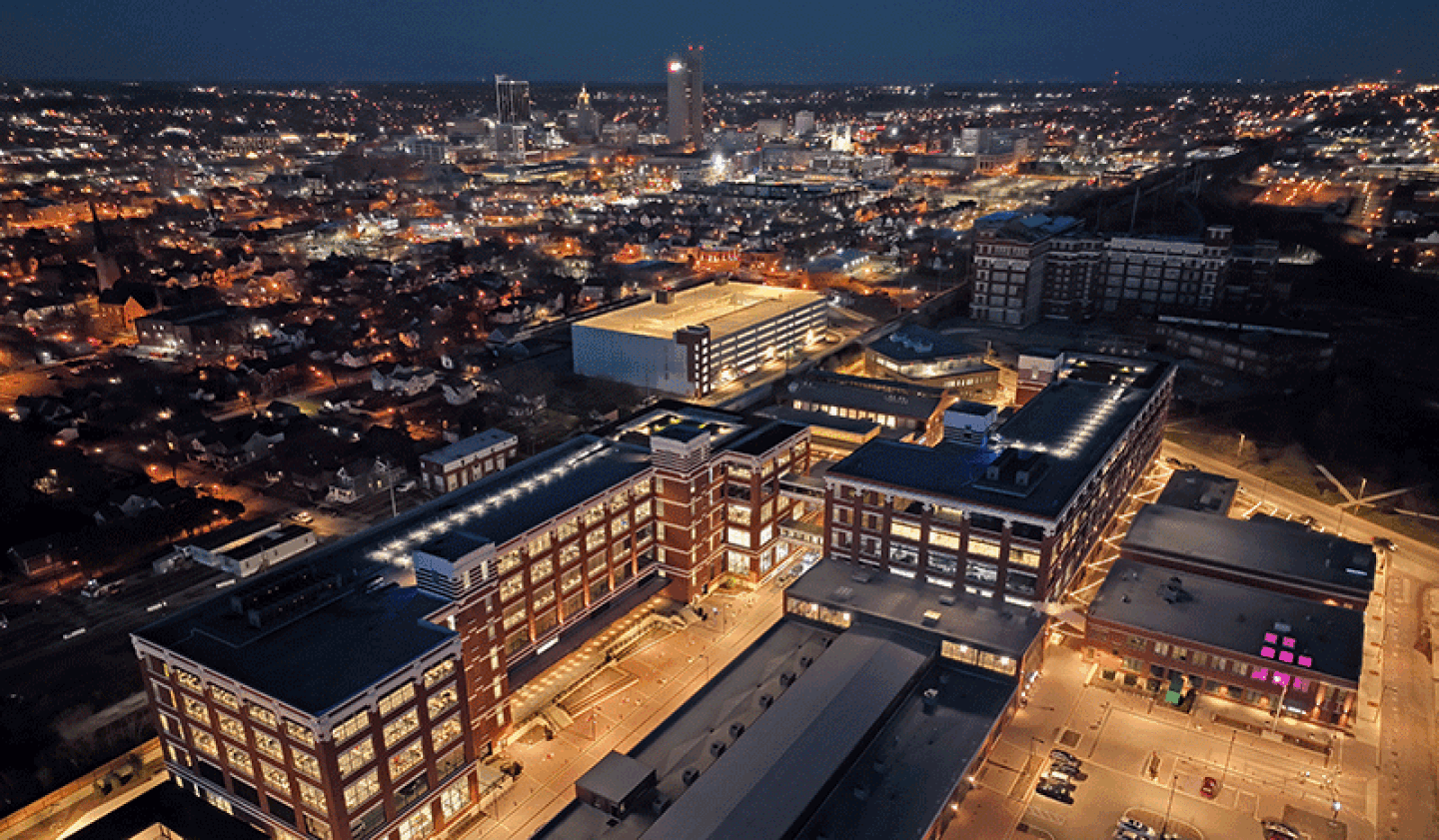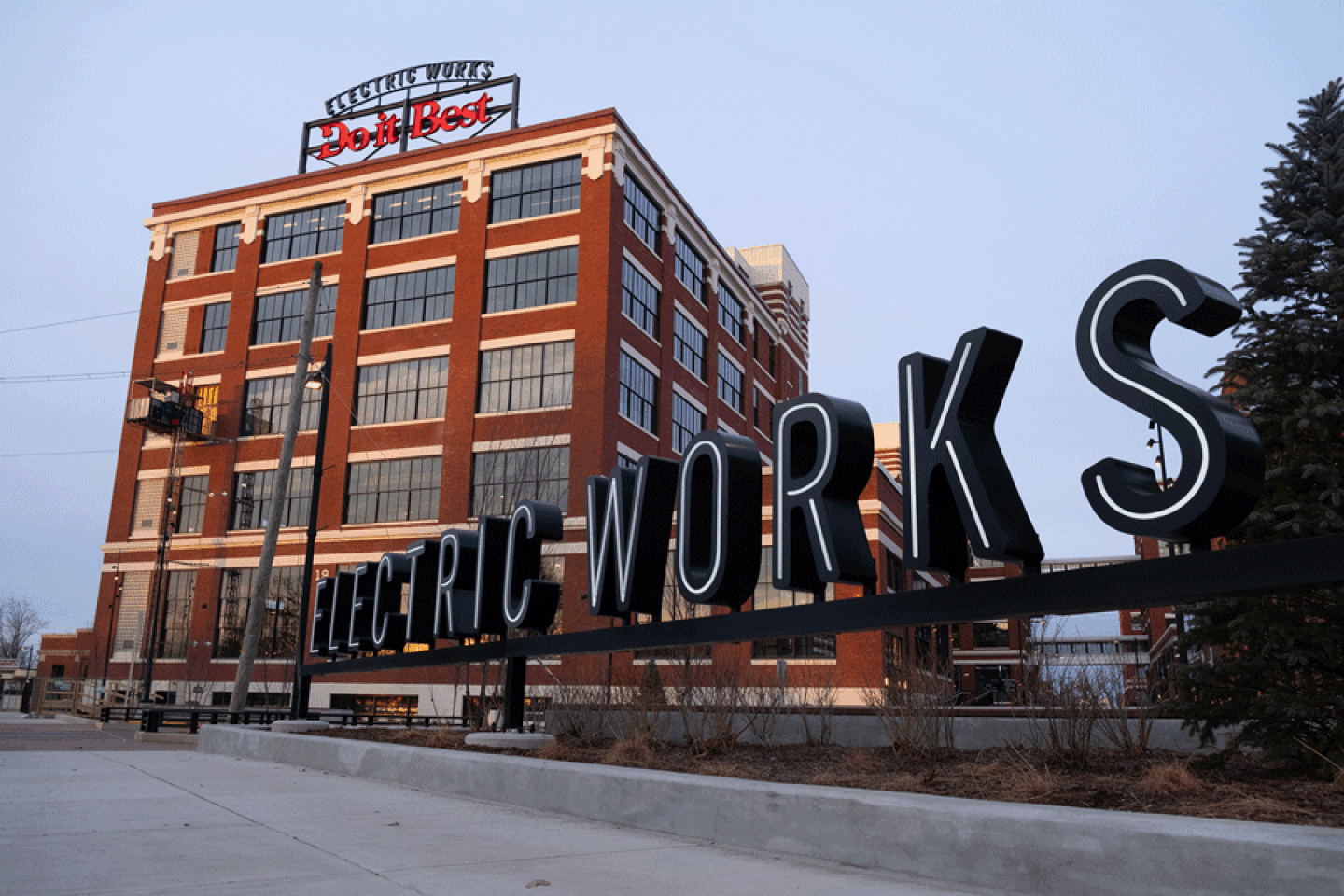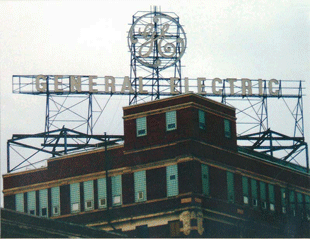After nearly eight years, workers are returning to a former General Electric (GE) factory in Fort Wayne. A complex financial package helped create a new home for one of Indiana’s largest employers at this postindustrial site in the U.S. Midwest.
On January 10, a crane lifted a 50-by-21-foot (15.2 by 6.4 m) sign to the roof of Building 19 in the former GE complex that once employed as many as 10,000 people. The lighted sign bore two names: Electric Works, the new moniker of the sprawling 39-acre (16 ha) campus on the edge of downtown Fort Wayne, and Do it Best, the growing hardware retailer that moved its headquarters to the property in December 2022.
The installation represented an important symbolic milestone for Electric Works, a $425 million mixed-use redevelopment of the manufacturing campus. After decades of deindustrialization and waves of job cuts at the Fort Wayne property, the 18-building complex was closed in 2015, with an iconic GE sign atop one building coming down the next year.
Since then, a group of developers, city officials, and civic leaders have come together to plan, finance, and build Electric Works. A development team led by Durham, North Carolina–based Ancora Partners is wrapping up the first phase of the project, which totals 700,000 square feet (65,000 sq m). Do it Best, Indiana’s largest private company, occupies about 200,000 square feet (18,600 m sq), moving about 425 employees there from its longtime corporate offices on the east side of town in early December.
Other phase-one tenants include a coworking operator, a food hall, a health clinic, a public high school, and other businesses. Totaling $286 million of public and private investment, the first phase is 69 percent pre-leased, says Jeff Kingsbury, cofounder of Ancora.
“We’re just getting started. A lot of what happens in these buildings is going to determine whether this project is a driver of innovation or just a cool mixed-use project,” he says. “We are intent on making sure programmatically that what happens in those buildings will differentiate the property as an engine for the next century as it was for the last century.”
What’s Next
Kingsbury expects to wrap up the financing for the second phase, estimated to cost $139 million, later in the first quarter. Phase two will include 280 apartments, a parking garage, a child-care facility, a fitness center, and commercial space.
Though the backers of Electric Works cannot declare victory yet, the progress so far offers an encouraging sign for Fort Wayne and other midsized Rust Belt cities as their leaders map out a postindustrial future. Going back 15 years or more, Fort Wayne has taken multiple steps to improve its downtown, focusing on publicly funded quality-of-life investments, like riverfront parks and a new minor league baseball stadium.
“I would call this a legacy industrial city working hard to reinvent itself,” says Rachel Blakeman, director of the Community Research Institute at Purdue University Fort Wayne. “The growth and investment and revitalization of downtown has been very intentional and purposeful. It hasn’t been an accident. There have been some lucky breaks.”
Lucky or not, the earlier projects created a strong foundation for Electric Works.
“It gave us the confidence that this was a community that was investing in itself,” Kingsbury says.
Complexity at Scale
It can take a strong stomach and extreme patience to put together an adaptive use project with the scale and complexity of Electric Works. A global pandemic, soaring construction costs, rising interest rates, and volatile financial markets have not made the job any easier. The project has also relied heavily on government funding—including more than $60 million from the city of Fort Wayne—the kind of thing that often draws criticism as a handout or a risky use of tax dollars.
“I had to measure that investment against putting that money in other projects,” says Mayor Tom Henry.
Yet Electric Works encountered little public resistance. Kingsbury was “overwhelmed” by the support from the Fort Wayne community, but not entirely surprised given its deep bonds to the GE property. If you lived in Fort Wayne and did not work at the GE campus at one point, a family member or friend did, he says. Kingsbury grew up in Fort Wayne next to a couple who spent their entire careers there.
“It goes back to the fact that so many people were connected to this place, and it was more than just a paycheck. This was their social center,” he says. “This was part of their identity, and they wanted that identity to be reimagined, but not as nostalgia.”
The property’s industrial history dates to the 1880s, when inventor James Jenney cofounded the Fort Wayne Jenney Electric Light Company there. GE bought the business around the turn of the 20th century and expanded the campus southwest of downtown over the following decades. At one point, GE, which had other plants in Fort Wayne, employed a third of the city’s workforce.
GE made a variety of electrical gear at the campus, including alternators, transformers, motors, and switches. The complex also churned out multiple inventions, including the garbage disposal and ice-making machine, a predecessor to the refrigerator. The property was so important to the nation’s defense in World War II that GE turned off its iconic sign there after the bombing of Pearl Harbor, worried it would be a target for enemy bombers.
But GE shrank its Fort Wayne workforce as it boosted efficiency and moved production to non-unit locations or overseas. The company employed fewer than 100 people in the city by 2014, when it decided to shut the complex down.
Preserve and Refashion
A couple of days after Christmas in 2015, Josh Parker, now Ancora’s CEO, toured the property. Parker had worked on a successful redevelopment of the American Tobacco campus in Durham, North Carolina, and thought that GE’s historic buildings might offer a similar opportunity. On the tour, his hosts told him the city would clear the property to provide a developer with a nice clean site. He did not like that idea.
“[Parker] said, “Stop! Don’t do that,’” according to Kingsbury.
By early 2017, a Parker-led development venture reached a deal to buy the GE property, with plans to preserve and refashion its buildings for other uses. Preliminary steps included environmental cleanup—mainly the removal of asbestos, lead-based paint, and contaminated soil.
The first-phase development also needed an anchor tenant. In February 2020, just as the COVID-19 pandemic was creeping into the United States, Do It Best signed a letter of intent to move to Electric Works. Mayor Henry and Governor Eric Holcomb were on hand for the announcement at the property.
It “was the tipping point that really got this project from ideation to execution,” says Do it Best spokesman Randy Rusk.
The company’s corporate employees had been operating out of a warehouse and office building since 1947 and needed a new modern and more collaborative space to retain and attract employees. The firm looked inside and outside the state for a new home before settling on Electric Works.
The lease represents a big commitment to office space at a time when many employers are shedding it as they embrace remote or hybrid work. But Do It Best never hesitated even as the pandemic intensified, Kingsbury says.
“Our focus is on creating an office environment that is so conducive to creating great work that people want to be there,” Rusk says. “That they would fear they’re missing out by not being there.”
Financing represented another big hurdle for Electric Works. Unable to assemble a complete financing package, the development group sought multiple extensions to a redevelopment agreement with the city that included $65 million in municipal funding. The project suffered a setback in August 2020, when the Fort Wayne Redevelopment Commission terminated the agreement.
“There was just this uneasiness about the depth of the investment group,” Henry says.
But the developers lined up a new equity partner—Tim Ash, CEO of local insurance brokerage Ash Brokerage—and managed to secure the commission’s approval. It was a complex package, including $48.5 million in federal historic and New Markets Tax Credits; $53.3 million in state tax credits; a $65.7 construction loan; $27.3 million in equity; and $61.2 million from the city. In all, the $286 million for phase one came from 20 different capital sources, Kingsbury says.
Financing the second phase of Electric Works has been easier. In October, a city panel approved $46 million in bonds to finance the project. Though phase one seemed too risky to investors Ancora approached outside Indiana, the firm found its equity partner for phase two outside the state, Kingsbury says. He declined to identify the investor.
“It took getting that first phase going and having proof of concept to take it to out-of-state investors,” he says.
If Ancora can deliver on Electric Works, more real estate investors may warm up to Fort Wayne. Some trends there are moving in the right direction. The metro area, for instance, has added residents every year since 2016 and stands out among Midwest peer cities for population growth. Multiple mixed-use developments in the city are underway or in the works, and other companies, like Swiss Re, are moving downtown.
A Midwestern Bright Spot
Among the Midwest cities adapting to post-manufacturing life, “Fort Wayne is kind of at the top of the list,” says Don Carter, senior research fellow at the Remaking Cities Institute at Carnegie Mellon University in Pittsburgh.
Blakeman, of Purdue University Fort Wayne, agrees that the city has made good progress but stresses that the job is far from over.
“Things are going well. It’s not without its challenges,” she says. “I’m always cautious—don’t buy your own hype.”
Learn more about ULI’s work in Fort Wayne on Knowledge Finder.








